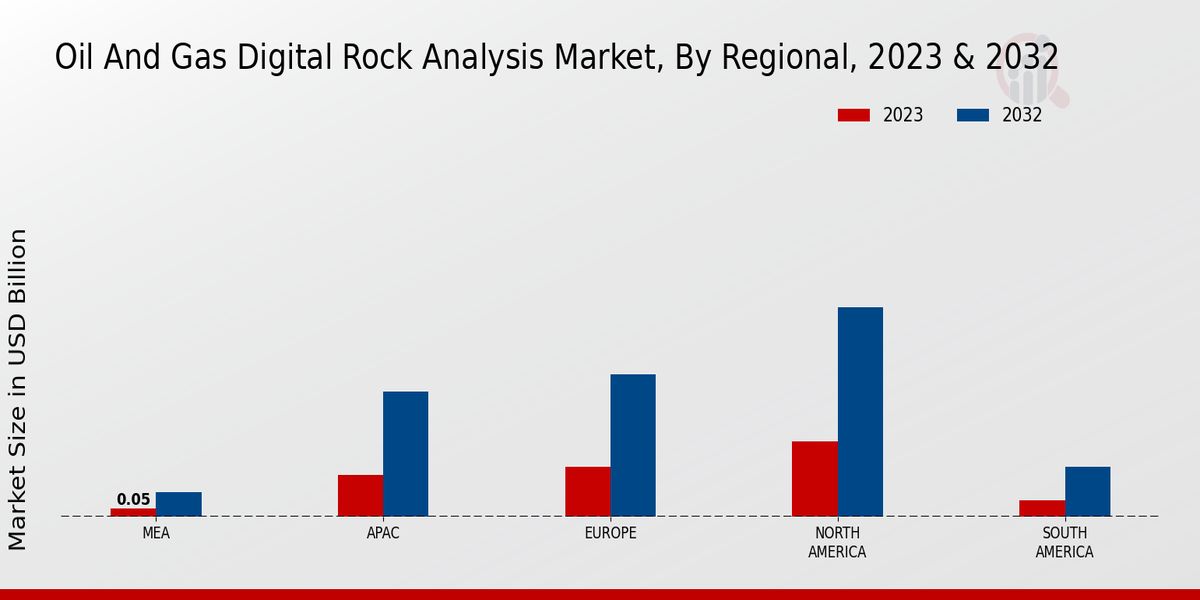Cost Efficiency
The Global Oil And Gas Digital Rock Analysis Market Industry benefits from the cost efficiency associated with digital analysis methods. Traditional rock analysis techniques can be time-consuming and expensive, often requiring extensive laboratory work. In contrast, digital rock analysis streamlines the process, allowing for quicker turnaround times and reduced operational costs. This efficiency is particularly appealing to companies operating in a volatile market, where cost management is paramount. As a result, the adoption of digital technologies is anticipated to rise, further driving market growth.
Regulatory Compliance
The Global Oil And Gas Digital Rock Analysis Market Industry is influenced by stringent regulatory frameworks aimed at environmental protection and resource management. Governments worldwide are implementing regulations that require detailed geological assessments before drilling activities commence. Digital rock analysis provides the necessary data to ensure compliance with these regulations, thus reducing the risk of environmental damage. This compliance-driven approach is likely to bolster market growth, as companies seek to adopt technologies that facilitate adherence to regulatory standards.
Market Growth Projections
The Global Oil And Gas Digital Rock Analysis Market Industry is projected to experience robust growth, with a compound annual growth rate of 13.19% anticipated from 2025 to 2035. This growth trajectory indicates a strong demand for digital rock analysis solutions as companies increasingly recognize the value of data-driven decision-making in resource exploration and extraction. The market's expansion reflects the ongoing transformation within the oil and gas sector, where digital technologies are becoming integral to operational strategies.
Technological Advancements
The Global Oil And Gas Digital Rock Analysis Market Industry is experiencing a surge in technological advancements that enhance the accuracy and efficiency of subsurface analysis. Innovations in imaging techniques, such as X-ray computed tomography and nuclear magnetic resonance, allow for detailed visualization of rock properties. These advancements enable operators to make informed decisions regarding resource extraction, thereby optimizing production. As a result, the market is projected to reach 1.3 USD Billion in 2024, reflecting the growing reliance on sophisticated analytical tools in the oil and gas sector.
Increased Demand for Energy
The Global Oil And Gas Digital Rock Analysis Market Industry is driven by the escalating demand for energy worldwide. As populations grow and economies expand, the need for efficient energy sources intensifies. Digital rock analysis plays a crucial role in identifying and quantifying hydrocarbon reserves, thereby facilitating the development of new oil and gas fields. This demand is expected to propel the market to 5.07 USD Billion by 2035, highlighting the importance of digital technologies in meeting future energy needs.
Collaboration and Partnerships
The Global Oil And Gas Digital Rock Analysis Market Industry is witnessing an increase in collaboration and partnerships among key stakeholders. Companies are forming alliances with technology providers, research institutions, and academic organizations to enhance their analytical capabilities. These collaborations enable the sharing of knowledge and resources, fostering innovation in digital rock analysis techniques. Such partnerships are expected to contribute to the market's growth, as they facilitate the development of cutting-edge solutions that address the evolving needs of the oil and gas sector.


























Leave a Comment